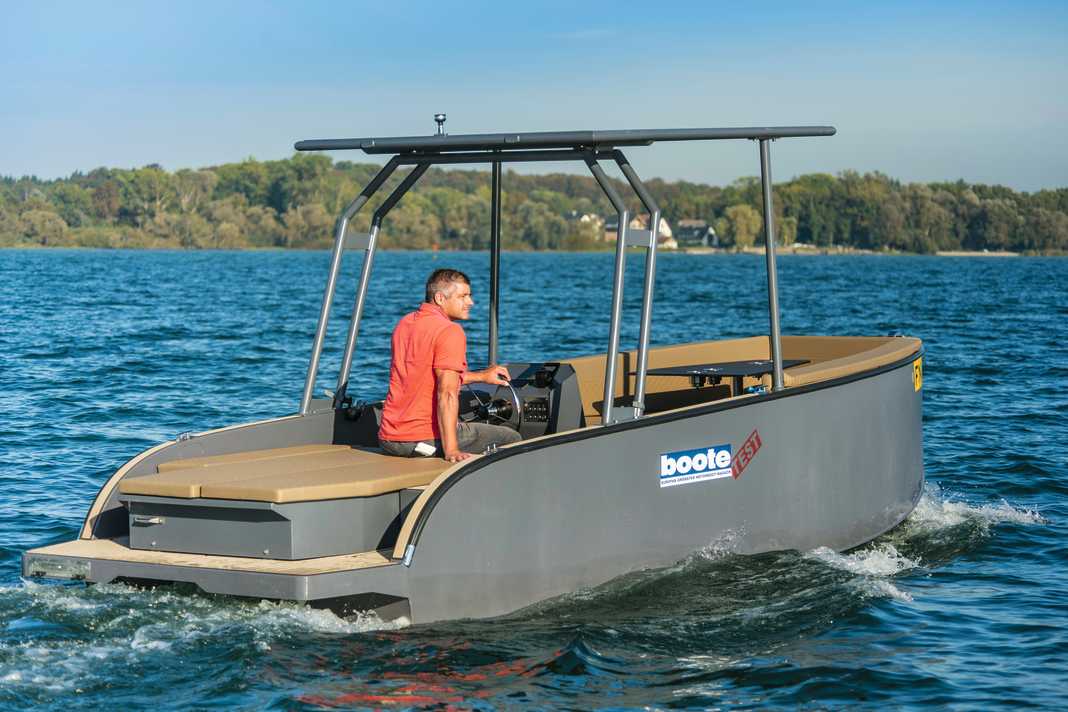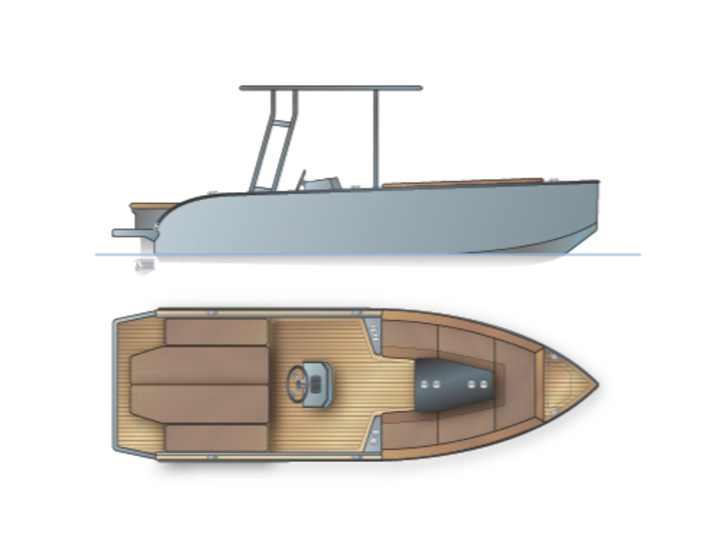





The young Polish shipyard Futuro Boats from Gdynia on the Baltic coast specialises in aluminium constructions. To date, four models between 5.5 and 9.5 metres in length are on offer. With the exception of the new flagship, these are open day cruisers with the option of fitting an inboard or outboard motor. Or - as with the 6.6 metre long Futuro ZX 20L Solar - an electric drive can be installed, the batteries of which can be charged using solar cells. This is what the German importer, Mizu GmbH from Hilzingen, offers. Otherwise, the boat is available with outboards between 11 and 37 kW (15 to 50 hp) or inboards from Volvo Penta or Mercruiser from 147 to 184 kW (200 to 250 hp), all with Lake Constance approval.
Layout on board the Futuro ZX 20L Solar
On the test boat, the two gangways leading from the bathing platform next to the sunlounger are fitted with storage boxes for the batteries. This increases the surface area of the sun lounger, which measures 1.90 x 1.80 metres. It continues with the helm station, which is mounted in the centre console in front of the sun lounger. The equipment with the standard hydraulic steering, a display for drive monitoring and the throttle lever is spartan. There is no compass. The bathing ladder is supplied at extra cost. The other safety equipment is complete with a fire extinguisher and an electric and a manual bilge pump. The workmanship and installation of the technology are flawless. The solar panels provide shade for the helm position. The front area of the sunbed is used as a seat for the helmsman. At the front there is a large seating area with a V-shaped cushion and table, which can also be used as a sunbed.
Efficient cruising speed with electric drive
The test boat is fitted with an FMT Momentum M170 electric drive, which has an operating voltage of 48 volts and a maximum output of 11 kW. The hubless drive is a permanent magnet synchronous motor mounted on a converted Z-drive. The propeller blades are guided on the outside of the rotor, eliminating the need for a hub. Four Forster F48-50X lithium iron phosphate batteries, each with 48 volts and 50 Ah, which can store 2560 watt hours of energy, are installed for the power supply. In purely mathematical terms, this means a total of up to 10,240 Wh on board. The advantages of the technology are safety - the batteries cannot catch fire - and a long service life. The manufacturer claims more than 4000 charging cycles at 80 per cent discharge. This promises a long service life. The installed solar cells have a maximum output of 660 Wp.
Read also:
The test drives revealed an efficient cruising speed of 3.5 knots at 1300 rpm. According to the display, this draws 45 Ah from the batteries. In purely mathematical terms, this results in a service life of four hours or a range of around 14 nautical miles. If the speed is increased slightly to 1500 rpm, just under 4.0 knots are possible, but the power consumption increases to 65 amps per hour. At top speed, which we reach at 5.4 knots, a whopping 192 amps flow through the thick copper cables at 2140 revolutions. The rated speed of 2400 revolutions is not quite reached.
Manoeuvring with the Futuro ZX 20L Solar
It should be noted that the driving behaviour is leisurely. Manoeuvring is possible in confined spaces with turning circles of 1.5 to 2 boat lengths. If you are interested in the solar pleasure, you will have to pay 53,550 euros for the basic version of the boat without drive. The electric version is currently not available with the test motor, but with a 48-volt, 10 kW underwater motor from Fischer Panda. The battery pack is at the same power level as the test boat, the solar bimini now has 800 Wp. Including installation, the cost of this drive is 37,842 euros. Torqeedo motors can also be installed. More powerful battery packs are available as an option. The supplier also mentions state subsidy options.
Technical data

- Shipyard: Futuro Boats
- Type: ZX 20L Solar
- Length: 6,60 m
- Width: 2,00 m
- Test boat weight: 1160 kg
- Draught with drive: 0,45 m
- Battery capacity: 200 Ah
- Maximum input power: 11 kW
- Maximum solar power: 660 Wp
- Price (current basic equipment) from: 91 392€
- Further information: www.mizu-marine.de
Measurement results
Advantages
- + Solar drive possible
- + very quiet
- + good workmanship
Conclusion
The electric technology works - but with considerable limitations in terms of range and performance. This is why the technology in the test boat quickly reaches its limits in windy conditions or currents.

